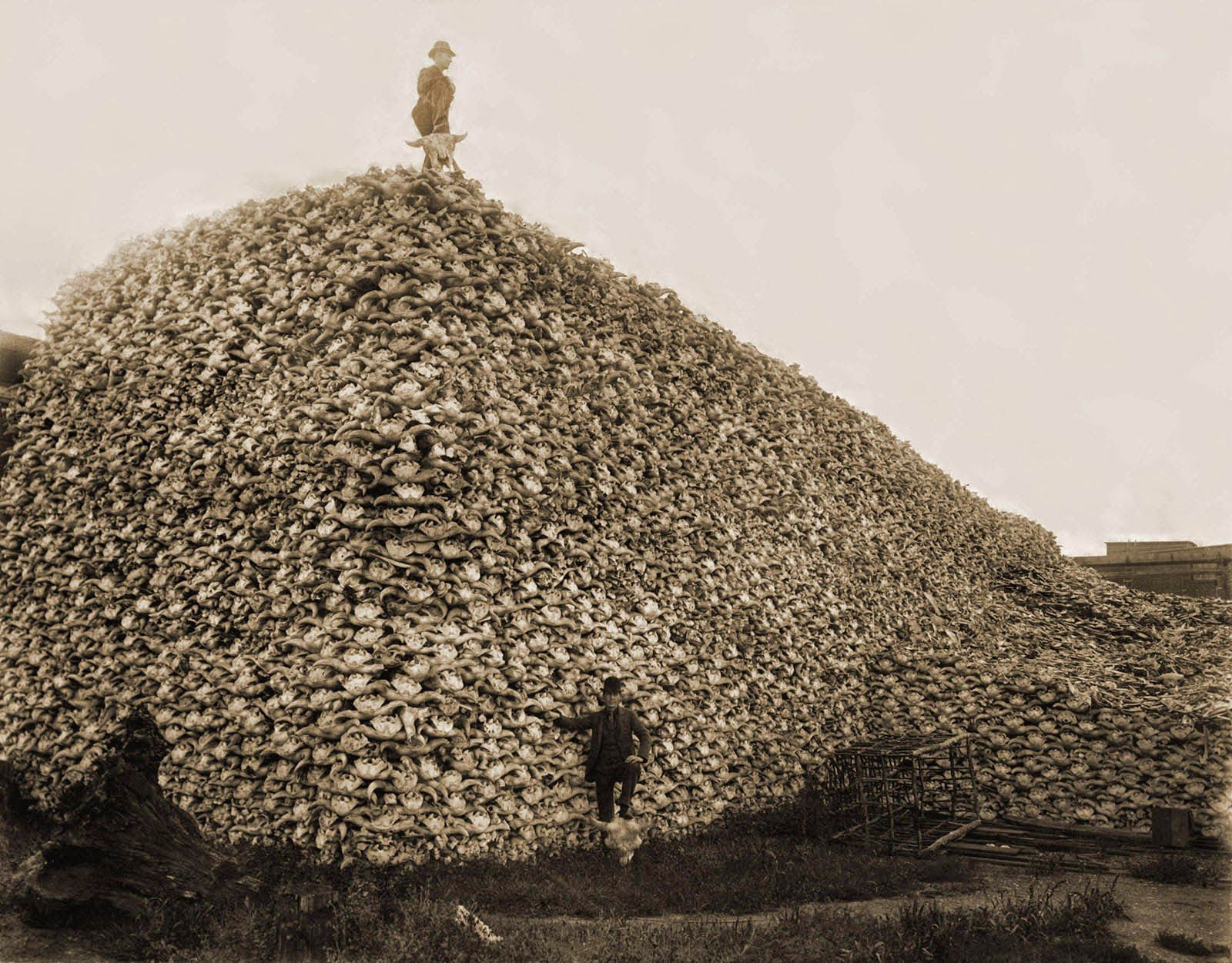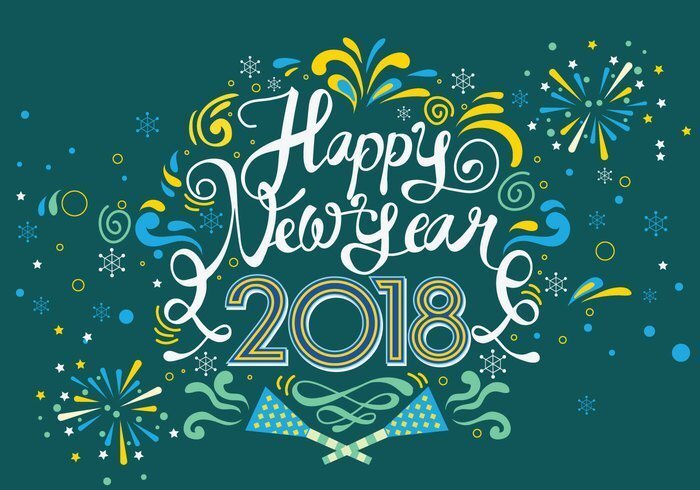https://www.fws.gov/bisonrange/timeline.htmHome TIME LINE of the AMERICAN BISON
Dates
Estimated Bison Population
Pressures on Bison
Legislation Concerning Bison
Recovery Efforts
1500's
An estimated 30 to 60 million bison living in North America.
1700's
to
1800's
As Euro-Americans settled the country, moving westward from the east coast, they brought changes to native habitat through plowing and farming. Introduced cattle diseases and grazing competition with feral horses also impacted bison prior to direct impact by Euro-Americans.
1802
Bison gone from Ohio, pushed out by pioneers and settlers.
1820
Native Americans tribes, forced off land in the east, bring horses and guns to the Great Plains and increased pressure on bison.
1830
Mass destruction of the once great herds of bison began.
1840's
West of the Rocky Mountains, bison (never in large numbers) disappeared. Native Americans market hunters concentrated on cow bison, because of their prime hides for trading.
1844
This may have been the peak year for the Hudson=s Bay Company as 75,000 bison robes were traded to posts in Canada.
1860's
Railroads built across the Great Plains during this period divided the bison into two main herds - the southern and the northern. Many bison were killed to feed the railway crews and Army posts. During this time, ABuffalo Bill@ Cody gains fame.
In 1864, the Idaho State Legislature passed the first law to protect the bison - after they were gone from the state.
In 1866, Charles Goodnight, at the request of his wife, captured a few free ranging bison calves and began a captive herd on his ranch in Texas. The bison were sold shortly after, unbeknownst of Mr. Goodnight.
1870
An estimated two million bison were killed this year on the southern plains. Germany had developed a process to tan bison hides into fine leather.
Homesteaders collected bones from carcasses left by hunters. Bison bones were used in refining sugar, and in making fertilizer and fine bone china. Bison bones brought from $2.50 to $15.00 a ton. Based on an average price of $8 per ton they brought 2.5 million dollars into Kansas alone between 1868 and 1881. Assuming that about 100 skeletons were required to make one ton of bones, this represented the remains of more than 31 million bison.
It became obvious in the 1870's that owning bison was profitable. More and more people were capturing free ranging bison to establish private herds.
1871
This year marked the beginning of the end of the southern herd. The greatest slaughter took place along the railroads. One firm in St. Louis traded 250,000 hides this year. Demand for bison skins escalated as a Pennsylvania tannery began commercially tanning bison hides. With this newly discovered tanning process, bison were now hunted year round.
Territorial delegate R.C. McCormick of Arizona introduced a bill that made it illegal for any person to kill a buffalo on public lands in the United States, except for food or preserving the robe. The bill indicated that the fine be $100 for each buffalo killed. Mysteriously, this document disappeared.
Wyoming passed a law prohibiting the waste of bison meat. Since such laws were not enforced, they did little to protect the bison.
1872
During this year and the next two, an average of 5,000 bison were killed each day, every day of the year, as ten thousand hunters poured onto the plains. One railroad shipped over a million pounds of bison bones. Bison hunting became a popular sport among the wealthy.
The Kansas legislature passed a law prohibiting the wasting of bison meat, but the Governor vetoed it.
Colorado passed a law prohibiting the wasting of bison meat; it was not enforced.
The legislation creating Yellowstone National Park provided Aagainst the wanton destruction of the fish and game found in said park@. Staffing and funding were not provided to enforce this law.
1873
On the southern plains, slaughter reached its peak. One railroad shipped nearly three million pounds of bones. Hides sold for $1.25 each, tongues brought 25 cents a piece - most of the bison was left to rot. A railway engineer said it was possible to walk A100 miles@ along the Santa Fe railroad right-of-way by stepping from one bison carcass to another.
Columbus Delano, Secretary of the Interior, under President Grant, wrote in his 1873 report, AI would not seriously regret the total disappearance of the buffalo from our western prairies, in the effect upon the Indians. I would regard it rather as a means of hastening their sense of dependence upon the products of the soil and their own labors.@
In 1872 or 1873 with the aid of his wife Sabine, Walking Coyote, a Pend d=Oreille Indian, acquired some bison calves, bringing them into the Flathead Valley with the intent of starting a bison herd.
In Canada, west of Winnipeg, James McKay acquired five bison and established a small herd.
1874
This year marked the seeming end of the great southern herd. Auctions in Fort Worth, Texas were moving 200,000 hides every day or two. One railroad shipped nearly 7 million pounds of buffalo bones.
Congress advanced their efforts to save the bison. Both the House and Senate passed a bill that protected female bison and did away with wanton destruction. However, President Grant refused to sign the bill.
Around this time, William and Charles Alloway of Manitoba, Canada, with the aid of a milk cow, captured three bison calves to start their own herd.
1875
Few bison remained in Texas when the state legislature moved to protect the bison. However, General Phil Sheridan appeared before the assembly and suggested that every hunter be given a medal Awith a dead buffalo on one side and a discouraged Indian on the other.@ He added that once the animals were exterminated, the Indians would be controlled and civilization could advance.
1876
The estimated three to four million bison of the southern plains were now dead. The Northern Pacific Railroad, anxious to advance, ignored tribal treaties and sent in a survey party. Native Americans killed some of the men, and General George Custer was sent to investigate, making history with the Battle at Little Big Horn.
1877
A few remaining free roaming bison were discovered in Texas and were killed.
A law was passed in Canada that forbade the use of pounds (corrals), wanton destruction, killing of buffalo under 2 years of age, and the killing of cows during a closed season.
Lt. Col. Samuel Bedson of Stoney Mountain, Manitoba (Canada) purchased bison from the Alloway herd, the McKay herd and from some Native Americans.
1878
Bison in Canada were disappearing rapidly.
Canada repealed the 1877 law.
1880
Slaughter of the northern herd had begun.
New Mexico passed a law to protect the bison; unfortunately the bison were already gone from this state.
1881
This year=s winter marked the largest slaughter of the northern herd. One county in Montana shipped 180,000 buffalo skins. Robes brought $2.50 to $4.00 each.
Around this time, the Glidden and the Dupree herds (of the Dakotas) were established.
1882
Over 10,000 bison were taken during one hunt of a few days length in Dakota Territory in September.
The fate of the northern herd had been determined. Hunters thought that the bison had moved north to Canada, but they hadn=t. They had simply been eliminated.
1883
By mid-year nearly all the bison in the United States were gone.
The Dakota Territorial Legislature enacted a law to protect bison; it was not enforced.
In Oklahoma, the McCoy brothers and J.W. Summers caught a pair of bison calves, 2 of very few left on the southern plains.
1884
There were around 325 wild bison left in the United States - including 25 in Yellowstone.
Congress gives the Army the task of enforcing laws in Yellowstone National Park in an effort to protect the final few wild bison from poachers.
Charles Goodnight re-established his herd.
Michel Pablo and Charles Allard of Montana purchased 13 bison from Walking Coyote for $2000 in gold.
1885
C.J. Jones purchased a few bison from Charles Goodnight, along with capturing 13 bison from southern Texas, starting his own private herd.
1886
The Smithsonian Institute sent an expedition out to obtain bison specimens for the National Museum. After a lengthy search, some were found near the LU Bar Ranch in Montana. Twenty-five were collected for mounting and scientific study. (The original mounted specimens were brought to the Fort Benton (MT) Museum of the Upper Missouri in the mid-1990's, close to where the original bison were taken.)
1887
The American Museum of Natural History (New York), wishing to obtain their own bison specimens for an exhibit, mounted an exhibition to Montana. They found no bison.
One of the last lots of bison robes sold in Texas for $10 per robe.
1888
Austin Corbin established a herd of bison on New Hampshire=s Blue Mountain Game Preserve.
1889
William Hornaday estimated total bison population to be just over 1000 animals - 85 free ranging, 200 in the federal herd (Yellowstone NP), 550 at Great Slave Lake (Canada) and 256 in zoos and private herds.
Last commercial shipments of hides anywhere in United States.
1896
The Pablo/Allard herd in the Flathead Valley totaled about 300. Allard died, and his widow sold her portion to Charles Conrad of Kalispell, MT.
1902
There were 700 bison in private herds. The Yellowstone herd was estimated at 23 animals.
1905
Government bison herds held about 100 animals (Yellowstone NP and the National Zoological Park in Washington, DC).
The American Bison Society founded by private citizens to protect and restore bison. Ernest Harold Baynes, founder; William T. Hornaday, president; Theodore Roosevelt, honorary president.
Hornaday (director of NY Zoological Park) gifted 12 of their bison to Wichita National Forest Preserve. This became the first gift of bison to establish/increase government herds.
1906 to 1912
Pablo sold his bison herd to Canada, after Congress turned down funding for purchase for the United States. After 7 years of rounding up, a total of 695 animals were shipped to Canada. Pablo received $170,000.
The National Bison Society donated 6 bison to the Fort Niobrara Game Preserve.
1908
National Bison Range established for A..a permanent ... Range for the herd of bison to be presented by the American Bison Society.@
1909
Thirty-four bison purchased from the Conrad herd (Kalispell, MT) by the American Bison Society, donated and release on National Bison Range.
1910
The American Bison Society Census estimated 2,108 bison in North American (1,076 in Canada and 1,032 in the U.S.). Bison in public herds in the U.S. totaled 151.
1913
Wind Cave National Park (SD) received 14 bison from the New York Zoological Society.
1919
Estimated population of North American bison at 12,521.
1924
The National Bison Range donates 218 bison from a herd total of 675 to other public herds. This is the first of many donations and sales of live bison.
1935
Because of the secure populations of bison in public herds, the American Bison Society votes itself out of existence.
1990's
An estimated 20,000-25,000 bison were in public herds in North America.
At least 250,000 bison in private herds by end of decade.
Private bison herds on the rise. Many bison raised for eventual slaughter - selling point of bison meat is it leanness and low levels of cholesterol. Many Native American Tribes reintroducing bison to their lands through the effort of the InterTribal Bison Cooperative and donations from federal herds.



